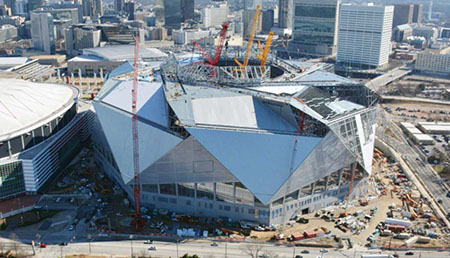NAB Show Reimagines Future
LAS VEGAS—What awaits at the 2017 NAB Show: A reconfigured FCC, a reshuffled spectrum marketplace, a newly opened door to next-gen TV broadcasts. And that’s before anyone even hits the show floor.
The industry has been busy in the past year, and as broadcasters head back to the Las Vegas for the show (April 24–27), expect to see issues like regulation, standards and new technology implementations dominate discussions.

AFTER THE AUCTION
This year’s NAB certainly looks different, particularly when one considers what the broadcast spectrum auction means for the industry.
Seen as equally intriguing and vexing, depending on who you ask, the first step in the complicated dance known as the broadcast spectrum auction was completed in January. Heading into NAB for the first time since the completion of the auction, companies like 21st Century Fox, Tribune Media and Gray Television will receive millions as part of the FCC’s airwave spectrum auction. As of press time, the auction had successfully repurposed 84 MHz of low-band spectrum, including 70 MHz of licensed spectrum and 14 MHz for unlicensed use.
Although TV station owners are expected to net about $10 billion, some have been disappointed by the auction results, starting with the NAB itself.
“Wireless providers spent years promoting the specious spectrum crisis claim,” said NAB Executive Vice President of Communications Dennis Wharton after the first stage of the auction. “Yet when they had the chance to solve this alleged crisis, the carriers suddenly closed their wallets.”
The next issue sure to be discussed during the show: the channel repack, a process that was set to begin near the beginning of April. The goal, NAB said, is to develop the right repacking plan and transition schedule that avoids service disruptions.
The professional video industry's #1 source for news, trends and product and tech information. Sign up below.
Broadcasting also took a big step forward on next-gen TV. In February, the FCC released a Notice of Proposed Rulemaking that would allow broadcasters to use the next-gen ATC 3.0 broadcast transmission standard on a voluntary, market-driven basis.
It’s a step that helps to encourage the voluntary adoption of next gen TV, NAB’s Wharton said. “This innovative broadcast transmission standard offers free and local TV viewers the promise of higher-quality pictures and sound, mobile viewership, datacasting and lifesaving interactive emergency information.”
This is just one of the steps taken by new FCC Chairman Ajit Pai, who took over the big chair at the commission in January.
In the weeks since his ascent to chairman, Pai has been busy working to untie a number of Tom Wheeler-era regulatory knots, including initiating a new pilot project that would give the public a clearer look at how the agency does its job, considering the modification of long-standing media ownership rules, and taking specific moves on the AM radio revitalization front.
So far, those decisions have garnered warm praise from the NAB. “Both items will foster technological innovation, increase opportunities for minority and female owners, and create new and unique services for consumers,” Wharton said after the release of notices on next-gen TV and AM radio.

Drones will be big at NAB Show this year. Last month, 300 drones flew above the NRG Stadium in Houston to pull together a synchronized dance of lights for Lady Gaga at Super Bowl 51.
Photo credit: Intel
DRONES ON THE RISE
Decisions made in Washington are expected to resonate across the show floor in Las Vegas, where innovations such as new drone technology and virtualization will garner the spotlight. This year’s show will be the first since the FAA issued new regulations on the commercial use of the drones, also known as “unmanned aircraft systems.”
If the Super Bowl was any indication, expect unique adoption of drone technology to continue. On Feb. 5, more than 300 drones flew above the NRG Stadium in Houston to pull together a synchronized dance of lights at Super Bowl 51, while local stations like Birmingham, Ala.-based WBRC noted that it was the first local TV station within its O&O group to launch aerial newsgathering with a UAS.
Interest in drones at the NAB Show has grown over the last two years. By the end of 2017, according to a new report from Gartner, drones are expected to rake in $7 billion in revenue. That number is expected to hit $11.2 billion by 2020.
“The commercial and personal drone markets are increasingly overlapping, as lower-priced personal devices are being used for commercial ventures,” said Gerald Van Hoy, senior research analyst at Gartner. “Recent technological advances blur the lines, allowing personal drones to be used in many special-purpose applications…”
ALL ABOUT IP
The show will also continue to examine changes in how viewers are consuming video.
Today’s average consumer is consuming four more hours of mobile video every week than they did in 2012 (even though traditional TV viewing time is down by 2.5 hours a week), according to a 2016 report from Ericsson ConsumerLab.

New sports venues, like the Mercedes-Benz Stadium in Atlanta, are investing in fully IP- and 4K-capable facilities.
That means broadcasters must continue to plot a future around new services and synergies, and adapt technology to deliver video in immersive ways. ATSC 3.0 addresses these issues but OTT, as well has become an integral part of how video content is made, delivered, consumed and monetized. A report released by the OTT firm Ooyala found that 52 percent of all video views in the third quarter of 2016 were on mobile devices, an increase of more than 230 percent since 2013, “outpacing the growing penetration rate of mobile devices globally,” the report said.
The NAB Show will also give attendees a glimpse at the progress being made in the ongoing transition to IP infrastructure. A growing number of companies—from Artel Video Systems and Video Clarity to Imagine Communications and Pebble Beach Systems — are showing IP-based solutions designed to transport live, broadcast-quality media. Imagine, for example, is one company that has announced tests on mobile production vehicles to support uncompressed HD and Ultra HD signals over IP.
Several companies said that the evolving nature of the video production landscape meant that it’s time to construct facilities that address this new delivery option, and to give engineers to tools to make it happen.
But the industry is also asking if the promise of IP meets up with the reality of operating in the real world. Some experts wonder if the high cost and potentially low ROI of installing an IP infrastructure is sufficient to move smaller facilities and broadcasters to install IP video systems in the near future. There’s also the issue of working with a fairly limited pool of talent with the skillset to maintain the technology in a broadcast facility, especially in the case of single-engineer-type stations.
There is certainly ongoing interest in IP from sports venues, such as replay facilities or score board feeds. This is especially true for new facilities like the Mercedes- Benz Stadium being constructed in Atlanta, which will serve as the home for NFL and MLS teams. Since facilities such as these see 4K as high value to their productions, IP does make this easier, said one industry expert. These venues get one shot at putting in a new facility—“so they might as well bite the bullet,” said one industry expert.
But a multitude of other issues—including standards and interoperability—must be addressed as the industry considers wide spread adoption.
VIRTUALIZATION AND THE CLOUD
A number of companies at the show plan to showcase how other technologies such as virtualization are playing out in the real world in sessions (with a mighty big promise) like “Virtualization in broadcast: Virtual Machines Can Reinvent Global TV Production.”
Likewise, individual manufacturers are seeing virtualization technology deployed with broadcasters. It’s a move that speaks to the real-world difficulties of continually updating a physical facility built around proprietary hardware.
“We believe that 2017 will be the year of virtualization,” said James Gilbert, CEO of Pixel Power, as more companies move beyond the proof-of-concept stage and begin to deliver virtualized systems.
The cloud is expected to again be of key interest, as companies such as Qligent, Quantum, Masstech show cloud-based technologies in the cloud.
There’s no denying the transition to IP, the cloud and virtualization over the last few years, “and we’re at a moment where it’s not a question of will they be adopted, but rather that they are happening,” said Glodina Connan-Lostanlen, chief marketing officer of Imagine. “The question is, how can we help customers go through this transition and really help explain how they can do it technically, how they can get the best benefit of the technology.”
The pace of change has kept the standards bodies busy, too. There is widespread industry support for the long-awaited SMPTE ST 2110 IP, standard for media transport over IP. There is also continuing support for the AES67 audio networking standard, published by the Audio Engineering Society.
SMPTE will co-host a two-day “Future of Cinema Conference” at NAB that will look at how cinema will be shaped by new technical innovations, artistic intent and evolving consumption and business models. The conference will tackle issues such as cloud technology, cinema projection and displays, immersive audio and HDR.
Other key events at the show include a Q&A with Steven Swartz, president and CEO of the Hearst media and entertainment company; the annual State of the Broadcast Industry address given by NAB President and CEO Gordon Smith; the induction of journalist María Elena Salinas into the NAB Broadcasting Hall of Fame; and the awarding of the NAB Television Chairman’s Award to actress America Ferrera for her achievement in television and her advocacy of women and immigration rights.
For more information on the show, visitwww.nabshow.com.
Susan Ashworth is the former editor of TV Technology. In addition to her work covering the broadcast television industry, she has served as editor of two housing finance magazines and written about topics as varied as education, radio, chess, music and sports. Outside of her life as a writer, she recently served as president of a local nonprofit organization supporting girls in baseball.

